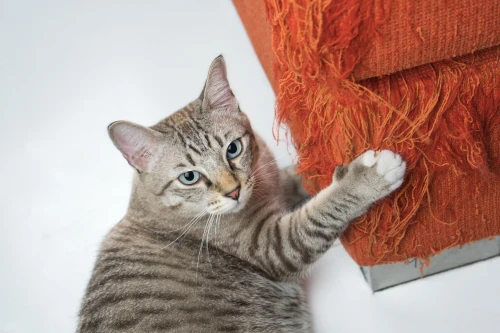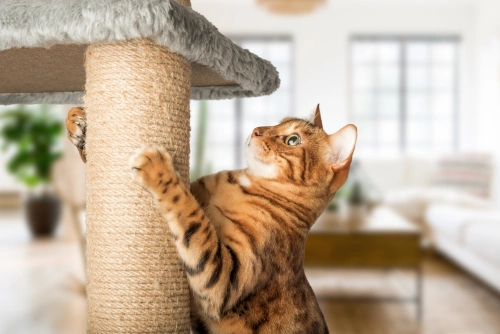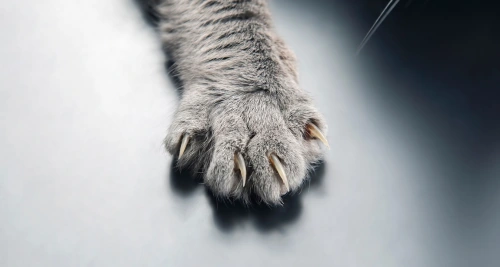Key Takeaways
Declawing cats is a surgery that removes part of the cat’s toe bone, not just the claws
Most veterinary and welfare organizations oppose it, including AVMA, AAFP, AAHA, ASPCA, Humane Society, and WSAVA
Preventing furniture damage is the main reason owners choose declawing, with 86% citing household destruction
Declawing may cause long-term health issues, including chronic pain, arthritis, and increased biting, inappropriate urination, and overgrooming
It violates key animal welfare principles, including the Five Freedoms and Five Opportunities to Thrive
Alternatives to declawing exist, such as scratching posts, nail trimming, and positive reinforcement behavior training
Understanding cat behavior reduces frustration, helping owners manage scratching without surgery
Declawing is declining in popularity, with bans in over 25 countries and shifting attitudes in the United States
Responsible cat ownership requires planning, including accepting and managing natural scratching behaviors
Consult a veterinarian or behaviorist for humane solutions before considering declawing
Declawing cats is a surgical procedure involving the removal of a cat’s claws and part of the third phalanx (toe bone). While some owners seek this surgery to prevent unwanted scratching, declawing has ethical, behavioral, and medical implications to consider. Many veterinary organizations, including the American Veterinary Medical Association (AVMA), the American Association of Feline Practitioners (AAFP), the American Animal Hospital Association (AAHA), and the World Small Animal Veterinary Association, discourage elective declawing due to potential long-term effects on feline wellbeing. Banfield, one of the world’s largest pet hospitals, states, “Current evidence does not support the use of elective declawing surgery as an alternative to relinquishment, abandonment, or euthanasia.”
Additionally, organizations such as the Humane Society, ASPCA, Pet Professional Guild, and Fear Free have positions opposing elective declawing with possible exception for rare cases where it may be medically necessary.
Why Do Owners Choose to Declaw Their Cats?

The primary reason most owners opt for declawing is to prevent damage to furniture and household items. Studies indicate that owners declaw 86% of cats to prevent household destruction. Other reasons include preventing injury to people and reducing potential harm to other pets.
Some owners report improved bonding and satisfaction post-procedure. However, these perspectives often focus on human convenience rather than potential behavioral and physiological consequences for the cat. Some research has linked declawing to increased biting tendencies, litter box avoidance, and signs of chronic pain. However, researchers need to conduct more studies to draw conclusions with a high degree of confidence.
The Ethical and Welfare Considerations
Declawing cats contradicts key principles of the Five Freedoms and the Five Opportunities to Thrive, which stress the importance of animals being free from pain, distress, and discomfort while also allowing them to express natural behaviors. Scratching is an essential species-specific behavior that contributes to a cat’s physical and emotional wellbeing. Disrupting this behavior can have long-term consequences.
The Pet Professional Guild explicitly states that declawing violates three of the Five Freedoms: freedom from pain, injury, or disease; freedom to express normal behavior; and freedom from fear and distress.
From an animal welfare perspective, concerns over declawing extend beyond the immediate pain of surgery. Scratching serves multiple essential functions, including marking territory, maintaining nail health, and stretching. When a cat loses its claws, it may struggle to perform these activities, potentially leading to distress and frustration.
Studies indicate that declawed cats may develop musculoskeletal issues, chronic back pain, arthritis, or behavioral problems such as excessive licking and aggression. Two in three cats show long-term signs of pain following the declaw procedure, and one study found that 78% of cats significantly increased their bite rate.
However, the long-term effects of declawing remain a subject of debate within veterinary and pet-owner communities, as research findings on these impacts can be complex and sometimes contradictory.
Alternatives to Declawing Cats
Indoor/Outdoor Cat Debate
“Positive reinforcement practices (rewarding the use of appropriate scratching objects) were associated with reduced unwanted scratching and the use of positive punishment (verbal and physical correction) was associated with increased displays of unwanted scratching.”
-Anastasia C. Stellato, PH.D
Providing appropriate outlets for scratching behavior is an important part of feline care, and many alternatives exist that can prevent damage without the need for surgical intervention. Here are some humane alternatives:

Scratching Posts and Boards: Studies suggest that cats prefer specific materials such as rope or carpet-covered scratching posts. Multi-level cat trees and vertical scratching posts at least 3 feet tall with a narrow base width are particularly effective.
Regular Nail Trimming: Routine claw maintenance reduces the likelihood of deep scratches.
Positive Reinforcement and Training: Reward-based training can redirect scratching to appropriate surfaces. Whereas punishment based interactions can actually make the undesired behaviors more prevalent. According to a 2016 publication in the Journal of Feline Medicine and Surgery, “Such destructive behaviors can frustrate pet owners, who often resort to punishing the cat. This further increases anxiety, resulting in an exacerbation of the inappropriate scratching behavior.” Unfortunately, the most common method of handling undesired behavior by cat owners is scolding or discipline (35% of owners).
Furniture Protection: Covers, guards, and designated scratching areas can minimize damage to household items.
Even well-intentioned responsible pet owners can report unwanted scratching behavior even after attempting alternatives to declawing. This does not mean the owner must then pursue declawing. A study of hundreds of cat owners found that their data, “confirms that inappropriate scratching by cats is recognized by owners and that owners offer traditionally recommended substrates and types and styles of posts but do not necessarily offer the substrate or style most commonly preferred by cats.”
The Role of Owner Education and Self-Reflection
Many issues surrounding inappropriate scratching arise from a lack of understanding of feline behavior. Research indicates that owners who possess a greater awareness of cat behavior report fewer behavioral problems, are more tolerant of traditionally undesired behaviors, and are less likely to use punitive measures to stop unwanted behaviors. Misconceptions about scratching often lead to frustration, when in reality, patience, training, and environmental management can significantly reduce destructive tendencies.
Potential owners should consider whether they are prepared to accommodate natural feline behaviors before acquiring a cat. Just as dog owners accept the risk of chewed furniture or accidents, cat owners must acknowledge the possibility of scratched furniture and plan accordingly. If a pristine couch is prioritized over an animal’s wellbeing, it may be time for self-reflection on whether pet ownership is the right choice.
A Shifting Perspective on Declawing Cats
Although nearly 20-25% of cats in the United States are declawed, the practice, or at least its favorability, appears to be declining. It is banned in over 42 countries and several U.S. cities, with growing recognition of its ethical concerns. While some owners remain satisfied with the procedure, the broader trend suggests a movement towards alternative solutions that better align with modern feline welfare standards.
Conclusion
Indoor/Outdoor Cat Debate
“Guarding an animal is taking on a role whose patience must be linked to motivating love. Kittens need training and attention to become compliant adults without the characteristic behavior considered destructive by some guardians. Raising indoor cats needs adaptation to the cats’ natural scratching and climbing behavior.”
-Raíssa Coutinho de Lucena
Declawing remains a debated issue, just like the indoor-outdoor cat debate. While some owners report positive outcomes, veterinary organizations, professional pet care organizations, and welfare advocates strongly encourage non-surgical alternatives. With proper education, training, and environmental adjustments, cats can coexist harmoniously with their owners without the need for painful surgical intervention. Providing appropriate outlets for natural behaviors benefits both the cat and the owner, fostering a healthier and more understanding bond.
If scratching is a concern, consider consulting a feline behaviorist or veterinarian for guidance on alternatives. In the end, prioritizing a cat’s wellbeing while considering owner needs is a crucial step in responsible pet ownership.
